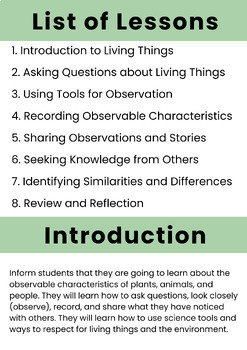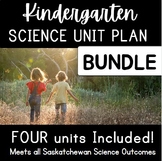Science Unit Plan: Kindergarten "Living Things" LTK.1 (Saskatchewan)
Also included in
- This Science Unit Plan Bundle includes lessons, resources, visuals, teacher notes, activities, discussion activities and more. Covers all the Saskatchewan Science Outcomes & Indicators for Kindergarten. View the previews to see what's included! Some of the other resources I have available includPrice $11.00Original Price $16.00Save $5.00
Description
Saskatchewan Science Unit for Kindergarten, observing characteristics of living things - Exploring Local Plants, Animals, and People. Contains mini lesson, activities, and teacher notes with all the knowledge you need. Covers all the indicators in the science curriculum. Could also be helpful for grade 1 or 2 as well.
LTK.1
Examine observable characteristics of plants, animals, and people in their local environment.CP, SI
Indicators for this outcome
(a)Pose questions about observable characteristics of plants and animals such as "Do all animals have four legs?", "How do fish breathe?", "Are all plants green?", and "Do plants breathe?"
(b)Record with assistance, observable characteristics (e.g., colour, texture, odour, teeth, number of limbs, method of movement, method of breathing, number of leaves, shape of leaves, type of leaves, eye colour, height, and hair colour) of plants, animals, and people found at school, home, or in the community, using terminology and language that others understand.
(c)Seek out information about the observable characteristics of plants, animals, and people from a variety of sources, such as family members, friends, Elders, knowledge keepers, and scientists.
(d)Select and safely use appropriate tools such as a hand lens (i.e., magnifying glass) and digital camera to observe plants and animals in the local environment.
(e)Show respect for the needs of other people, other living things, and the environment when observing and interacting with living things (e.g., show concerns for other students' feelings, care for living things that are kept in their classroom, and willingly suggest how we can protect the environment).
(f)Explore portrayals of plants, animals, and people through stories and artwork from various cultures, including First Nations and Métis.
(g)Share stories and observations of plants, animals, and people in the local environment with classmates or others.
(h)Identify similarities and differences in observable characteristics among different plants, among different animals, and among different people.
(i)Sort and classify pictures and drawings of plants, animals, and people using student-developed criteria.
(j)Create visual, dramatic, and/or multimedia representations of the characteristics of a student-selected plant or animal to share with classmates and others.





